Odisha State Board CHSE Odisha Class 12 Biology Solutions Chapter 6 Sex Determination Textbook Questions and Answers.
CHSE Odisha 12th Class Biology Chapter 6 Question Answer Sex Determination
Sex Determination Class 12 Questions and Answers CHSE Odisha
Very Short Answer Type Questions
Choose the correct option
Question 1.
A cross between Fj-hybrid and a recessive parent gives the ratio of
(a) 3 : 1
(b) 2 : 1
(c) 1 : 1
(d) 4 : 1
Answer:
(c) 1 : 1
Question 2.
A cross of F1 with the recessive parent is known as
(a) back cross
(b) test cross
(c) hybrid cross
(d) double cross
Answer:
(b) test cross
Question 3.
A woman with albinic father marries an albinic man. The proportion of her progeny is
(a) 2 normal : 1 albinic
(b) all normal
(c) all albinic
(d) 1 normal : 1 albinic
Answer:
(d) 1 normal : 1 albinic
Question 4.
Y-chromosome is called
(a) sex chromosome
(b) androsome
(c) autosome
(d) gynosome
Answer:
(a) sex chromosome
Question 5.
Which one is a sex-linked disorder?
(a) Leukemia
(b) Cancer
(c) Night blindness
(d) Colour blindness
Answer:
(d) Colour blindness
![]()
Question 6.
A haemophilic man marries a normal homozygous woman. What is the probability that their son will be haemophilic?
(a) 100%
(b) 75%
(c) 50%
(d) 0%
Answer:
(d) 0%
Question 7.
What is the probability that their daughter will be haemophilic?
(a) 100%
(b) 75%
(c) 50%
(d) 0%
Answer:
(d) 0%
Question 8.
A fruitfly exhibiting both male and female trait is
(a) heterozygous
(b) gynandromorph
(c) hemizygous
(d) gynandev
Answer:
(b) gynandromorph
Question 9.
Genes located on Y-chromosome are
(a) mutant genes
(b) autosomal genes
(c) holandric genes
(d) sex-linked genes
Answer:
(c) holandric genes
Question 10.
A colourblind person cannot distinguish
(a) all colours
(b) red colour
(c) green colour
(d) red and green colours
Answer:
(d) red and green colours
Question 11.
The gene responsible for haemophilia is linked to which chromosome?
(a) X
(b) Y
(c) Both X and Y
(d) Autosome
Answer:
(a) X
![]()
Question 12.
Red-green colour blindness in man is
(a) sex-linked character
(b) sex-limited character
(c) sex influenced character
(d) sexual character
Answer:
(a) sex-linked character
Question 13.
Sex-linked characters are
(a) dominant
(b) recessive
(c) lethal
(d) not inherited
Answer:
(b) recessive
Question 14.
Which gene is present in the Y-chromosome that codes for the protein TDF?
(a) cry
(b) sty
(c) try
(d) tra
Answer:
(b) sty
Question 15.
In birds, which type of chromosomal basis of sex-determination is present?
(a) XX – XY
(b) XX – XO
(c) ZW – ZZ
(d) ZZ – ZO
Answer:
(c) ZW – ZZ
Question 16.
When the ratio of X/A=0.67 in genic balance theory, which type of sex is expressed?
(a) Super female
(b) Intersex
(c) Super male
(d) Triploid female
Answer:
(b) Intersex
Question 17.
Which type of sex-determination is found in Bonellia?
(a) Temperature dependent
(b) Chemotactic
(c) Holandric
(d) Pseudoautosomal
Answer:
(b) Chemotactic
Question 18.
In a person with Turner syndrome, the number of X-chromosome is
(a) 1
(b) 2
(c) 3
(d) 0
Answer:
(a) 1
![]()
Question 19.
A Down syndrome will be
(a) 45 + XX
(b) 44 + XY
(c) 44 + XXY
(d) 22 + XY
Answer:
(a) 45 + XX
Question 20.
Number of Barr bodies present in Turner syndrome is
(a) 0
(b) 1
(c) 2
(d) Either (b) or (c)
Answer:
(a) 0
Express in one or two word(s)
Question 1.
Name two sex-linked diseases of human being.
Answer:
Haemophilia and colour blindness.
Question 2.
How Down’s syndrome is caused?
Answer:
Down’s syndrome is caused due to the presence of an extra-chromosome number 21, i.e. 21 trisomy.
Question 3.
In which chromosome is the gene for haemophilia located?
Answer:
X-chromosome
Question 4.
What is the chromosomal formula for Turner’s syndrome?
Answer:
44 + XO
Question 5.
Which sex is usually a carrier?
Answer:
Female sex
Question 6.
Who proposed the genic balance theory?
Answer:
Calvin Bridges
Question 7.
What are holandric genes?
Answer:
Genes located on Y-chromosomes are known as holandric genes
Question 8.
In which chromosome, the factors for haemophilia and colour blindness are found?
Answer:
X-chromosome
Question 9.
What is the other name of Bleeder’s disease?
Answer:
Haemophilia
Question 10.
Which protein is in sry gene of Y-chromosome?
Answer:
TDF (Testis Determining Factor)
Question 11.
What is gynandromorph?
Answer:
Exhibiting both male and female characters are called gynandromorphs.
Question 12.
What is freemartin?
Answer:
Sterile female with many male characteristics.
![]()
Question 13.
What is criss-cross inheritance?
Answer:
The transmission of characters from grandfather to grandson through daughter is called criss-cross inheritance.
Question 14.
Which type of defect is found in thalassemia?
Answer:
The mutation or deletion of the genes controlling the formation of globin chains of haemoglobin result in an abnormal form of haemoglobin.
Question 15.
Who first described Klinefelter’s syndrome?
Answer:
H. F. Klinefelter in 1942.
Short Answer Type Questions
Write brief notes on the following (within 50 words each)
Question 1.
Criss-cross inheritance
Answer:
The transmission of characters from grandfather to grandson through daughter is called criss-cross inheritance.
Question 2.
Holandric gene
Answer:
Genes located on Y-chromosomes are known as holandric genes
Question 3.
Haplo-diploidy mechanism of sex-determination
Answer:
Haplo-Diploidy Mechanism:
In insects-like honeybees wasps, ants, etc., the sex chromosomes are not differentiated and sex is determined on the basis of ploidy of the individual. In honeybees, drones are males and are haploid (n =16), which had developed from unfertilised eggs of females (Arrhenotoky).
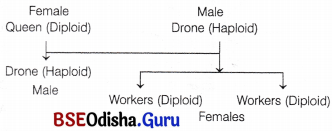
Question 4.
Genic balance theory
Answer:
Genic Balance Mechanism
The investigations on Drosophila by C. Bridges showed that female determiners were located on the X-chromosomes and that of male were on the autosomes. Hence, autosomes also plays an important role in determining sex in Drosophila melanogaster. Genic balance’ theory by Bridges proposed the sex-determination mechanism based on the ration of number of X-chromosomes (X) and sets of autosomes (A).
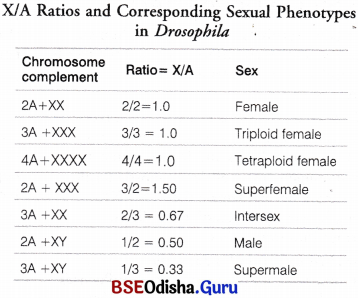
![]()
Question 5.
Freemartin
Answer:
It is an infertile female mammal with masculinised behaviour and non-functioning ovaries. Freemartinism is the normal outcome of mixed sex twins in all cattle species, i.e. it occurs when the twins of opposite sex are born also occurs occasionally in other mammals including sheep, goats and pigs.
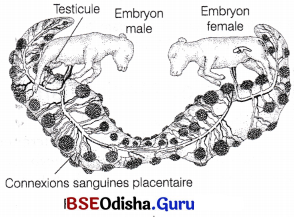
In most cattle twins, the blood vessels in the chorions become interconnected, creating a shared circulation for both twins. Mostly the male hormones are produced first. If both foetuses are of the same sex this is of no significance, but if they are of different sex, male hormones pass from the male twin to the female twin.
The male hormones then masculinise the female twin and the result is a freemartin or sterile masculine female.
Question 6.
Gynandromorph
Answer:
Abnormal chromosomal behaviour in insects can result in the formation of gynandromorphs or sexual mosaics in which some parts of the animal exhibit female characters and other parts exhibit male characters.
Some gynandromorphs in Drosophila are bilateral intersexes with male colour pattern, body shape, and sex comb on one half of the body and female characteristics on the other half.
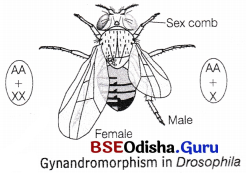
The failure of segregation (non-disjunction) of X-chromosomes at cleavage leads to formation of gynandromorphs. The chromosome complement of zygote is 2A + 2X. During first cleavage, one of the X-chromosomes is lost in one of the blastomeres.
As a result, one of the blastomeres acquires 2A + 2X complement which forms the female half while the other blastomere with 2A + X complement forms the male half. Thus, half of the body is female while the other half is male.
Question 7.
Single gene effect
Answer:
Single Gene Effect:
In certain organisms-like Drosophila, human, Asparagus and several fishes, a single gene pair is responsible for the determination and expression of sex.
In Drosophila, the sex is expressed by a recessive gene called tra (transformer) present on the third autosome. Males and female members with dominant (tra+) allele are mostly fertile. However, a normal female (i.e. AA + XX), having homozygous recessive tra alleles, develops into sterile male.
As studied earlier, in humans, the Y-chromosome has a sry gene which influences the development of testis in males. Its absence results in development of ovaries in females.
Thus, an XX female with sry gene or an XY male without sry gene ultimately develops into a sterile female.
Question 8.
Sex reversal
Answer:
Sex Reversal:
Artificial removal of gonads of either sex before puberty (castration or ovariectomy) results in the development of secondary sexual characters of the opposite sex. It is observed in fishes, amphibians, birds and some mammals, including humans.
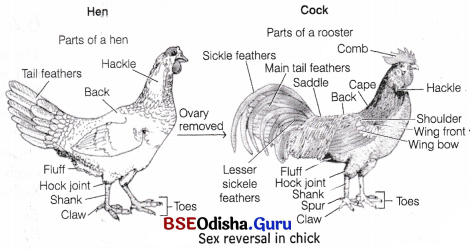
In the given figure, the hen develops male secondary sex characteristics after the removal of ovaries. Thus, the bird is still female genotypically but phenotypically it becomes male.
Question 9.
Temperature dependent sex-determination
Answer:
Temperature Dependent Sex-Determination:
In some reptiles, the temperature at which the fertilised eggs are incubated prior to hatching plays a major role in determining the sex of the offspring. Surprisingly high temperature during incubation have opposite effect on sex-determination in different species.
In turtles, high incubation temperature (above 30°C) of eggs results in the production of female progeny whereas in the lizard and crocodiles, high incubation temperature results in the production of male offspring. At the lower temperature range between 22.5-27°C, male turtles are produced. This pattern is reversed in lizards and crocodiles.
![]()
Question 10.
Chemotactic sex-determination
Answer:
Chemotactic Sex-Determination:
It is seen in males of the marine worm Bonellia. These are small, degenerate and live within the reproductive tract of the larger female. All organs of male worm’s body are degenerate except those of the reproductive system.
In Bonellia, the larvae of male and female are genetically and cytolosically similar, i.e. it is hermaphrodite. A newly hatched worm if reared from a single cell kept in isolation, it develops into a female. If the larvae are reared with mature females in water, they adhere to the proboscis.
Later they transform into males who eventually migrate into the female reproductive tract, where they become parasitic.
It has been found that a chemotactic substance secreted by the proboscis of a mature female Bonellia induces the differentiation of larva into males.
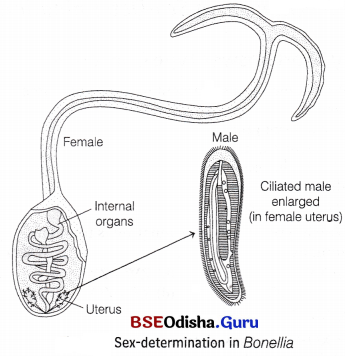
Question 11.
Thalassemia
Answer:
It is an autosomal recessive blood disease, which is caused due to reduced synthesis of either the α or ß-chains of haemoglobin, as a result of mutation in the genes of α or ß-chains. It was discovered by Cooley (1925) and is prevalent in Asia, middle-East, Africa and Mediterranian countries. Anaemia is the characteristic symptom of this disease. Depending upon the globin chain affected, thalassemia is classified into following types, i.e.
1. α-Thalassemia is caused by defective α-chain. The OC-globin is controlled by two genes present on chromosome 16, i.e. HBA1 and HBA2. α-thalassemia is of two types-haemoglobin H-disease and Hydrops Foetalis. The later is more severe as all the four globin genes are mutated and the defective alleles kill the foetus resulting in still birth or death soon after delivery.
Haemoglobin H-disease occurs when there are three defective alleles out of four α-globin genes.
2. ß-Thalassemia is caused by decreased synthesis of ß-globin chain. It is further classified into thalassemia major (Cooley’s anaemia), i.e. when both the alleles for ß-globin are defective or absent. It is more severe in comparison to the second type called thalassemia intermedia, i.e. when only one allele is defective in ß-globin.
Symptoms:
The common symptoms include tiredness, pale skin with severe anaemia, enlarged spleen, yellowish skin and dark urine.
Diagnosis Treatment and Prevention:
The disease is diagnosed by blood test and genetic analysis. There are two treatment options, i.e. blood transfusion and bone marrow transplantation. Genetic councelling is not recommended as it makes the persqn concious about the consequences of the disease.
Question 12.
Down’s syndrome
Answer:
Down’s Syndrome (Mongolism):
This syndrome was previously called mongolism because the affected persons were of short stature. The estimated frequence of birth of individual with Down’s syndrome is 1/700.
It was described by J Langdon Down in 1866 but its cause was found by Lejeune in 1959.
Genetic Basis:
It occurs due to chromosomal aberration, known as aneuploidy (trisomy). The individuals suffering from Down’s syndrome posses an extrachromosome number 21. Both the chromosomes of 21 position passes into a single egg due to primary non-disjunction which may occur during meiosis-I or II in maturation phase of gametogenesis. Thus, the egg instead of possessing 23 chromosomes have 24 chromosomes and the offspring has 47 chromosomes (45 + XY in males, 45 +XX in females). It is also seen in chimpanzees and other related primates.
![]()
Question 13.
Turner’s syndrome
Answer:
Turner’s Syndrome:
This condition is characterised by one missing X-chromosome which result in 45 + XO chromosomal complement in affected person. It was first described by H.H. Turner in 1938. The estimated birth frequency of Turner’s syndrome is 1/2500 live female births. It total frequency in human population is 1/5000.
Genetic Basis:
It is a disorder which is caused due to chromosomal aberration, known as aneuploidy (monosomy). Due to absence of one of the X-chromosome, the condition is 45 with XO. Primary non-disjunction in either of meiotic divisions during gametogenesis results in this condition.
Question 14.
Klinefelter’s syndrome
Answer:
Klinefelter’s Syndrome:
HF Klinefelter first described this condition in 1942.
This genetic disorder occurs due to the presence of an additional copy of the X-chromosome. It is also known as trisomy of X-chromosome. Its estimated birth frequency is 1/500 live male births.
Genetic Basis:
The union of an abnormal XX-egg with a normal Y-sperm or a normal X-egg with an abnormal XY-sperms results in the karyotype of 47, XXY in males or 47, XXX in females.
The abnormal eggs and sperms are formed due to the v primary non-disjunction ofX and Y chromosomes during the maturation phase of gametogenesis. Although the usual karyotype of this condition is 47 + XXY but sometimes more complex karyotypes also occurs, e.g. XXXY, XXXXY, XXXXXY, XXXXYY, etc.
Differentiate between two words in the following pairs of words
Question 1.
Phenotype and Genotype.
Answer:
Differences between phenotype and genotype are as
| Phenotype | Genotype |
| It refers to observable traits or characters. | It refers to the genetic constitution of an individual. |
| It results from expression of genes. | It constitutes single gene pair or sum total of all the genes. |
| The phenotypic ratio of Mendel’s monohybrid cross is 3 : 1. | The genotypic ratio of Mendel’s monohybrid cross is 1 : 2 :1. |
| It may change with age and environment. | It remains the same throughout the life of an individual. |
Question 2.
Autosome and Allosome.
Answer:
Differences between autosomes and allosomes are as follows
| Autosome | Allosomes |
| They are somatic chromosomes which control the body character or somatic characters. | They are sex chromosomes which determine the sex of an individual. |
| In humans, out of the total 23 pairs, of chromosomes 22 pairs are autosomes. | In humans, the 23rd pair of chromosome is called sex chromosome. |
Question 3.
X-chromosome and Y-chromosome.
Answer:
Differences between X and Y-chromosomes are as follows
| X-chromosome | Y-chromosome |
| It is sex chromosome. | It is also a sex chromosome. |
| Females have two X-chromosomes. | It is absent in females. |
| It is larger than Y-chromosome. | It is smaller than X-chromosome. |
| It does not contain sry gene. | It carries male determining gene called sry gene. |
Question 4.
Supermale and Superfemale.
Answer:
Differences between superfemales and supermales are as follows
| Superfemales | Supermales |
| Such individuals have 47(44 + XXX), 48(44 + XXX) chromosomes. | Such individuals have 47(44+YYY) chromosomes. |
| These females have abnormal sexual development and mentally retarded. | These males are characterised by abnormal height, mental retardation. |
Question 5.
Sex differentiation and Sex reversal.
Answer:
Differences between sex differentiation and sex reversal are as follows
| Sex differentiation | Sex reversal |
| It is the process of the differences between males and females from an undifferentiated zygote. | It is the phenomenon of development of secondary sexual characters of the opposite sex. |
| It is induced by specific genes by hormones and by anatomy. | It is induced by some chemicals. |
Question 6.
Gynandromorph and Freemartin.
Answer:
Differences between gynandromorphs and freemartin are as follows
| Gynandromorphs | Freemartin |
| It is the phenomenon in which a part of the body exhibits female characters, while the other part exhibits male characters, e.g. Drosophila. | When the,twins of the opposite sex are born, the male is normal but the female is sterile with many male characters. Such sterile females are called freemartin, e.g. cattle. |
| These develop due to failure of segregation of X-chromosomes at cleavage. | These develop due to influence of male hormone. |
Question 7.
Down’s syndrome and Turner’s syndrome.
Answer:
Differences between Down’s syndrome and Turner’s syndrome are as follows
| Down’s syndrome | Turner’s syndrome |
| It occurs due to the presence of an additional copy of the chromosome number 21. This condition is called trisomy of 21 chromosome. | It is a disorder caused due to the absence of one of the X-chromosome, i.e. 45 with XO. |
| It is an autosomal genetic disorder. | It is a sex-linked chromosomal genetic disorder. |
Long Answer Type Questions
Question 1.
Discuss the chromosomal theory of sex-determination.
Answer:
Chromosomal Mechanism of Sex-Determination:
The male and female individuals normally differ in their chromosomal constituents. There are two types of chromosomes, i.e.
- Sex chromosomes or Allosomes The chromosomes responsible for sex determination, e.g. X and Y-chromosomes.
- Autosomes The chromosomes which determines the somatic characters.
X-chromosome was first discovered by Henking (1891). He named this structure as X-body. Scientists further explained that X-body was a chromosome and called it as X-chromosome. The concept of autosomes and allosomes was proposed by Wilson and Stevens (1902-1905) in chromosomal theory of sex-determination.
There are various types of chromosomal sex-determination mechanism observed in different animals as follows
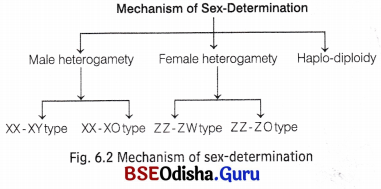
Sex Differentiation:
Sex-determination in lower grade animals can be explained successfully by the genic balance and chromosomal theory. However, this is not the case with vertebrates and in some invertebrates, where the embryo develops certain traits of opposite sex along with its own. This indicates that sex of an organism changes under specific conditions. This may happen as a result of hormones secreted from the gonads of such organisms.
Some examples of sex differentiation are given below
Sex Reversal:
Artificial removal of gonads of either sex before puberty (castration or ovariectomy) results in the development of secondary sexual characters of the opposite sex. It is observed in fishes, amphibians, birds and some mammals, including humans. ,

In the given figure, the hen develops male secondary sex characteristics after the removal of ovaries. Thus, the bird is still female genotypically but phenotypically it becomes male.
Freemartin:
It is an infertile female mammal with masculinised behaviour and non-functioning ovaries. Freemartinism is the normal outcome of mixed sex twins in all cattle species, i.e. it occurs when the twins of opposite sex are born: also occurs occasionally in other mammals including sheep, goats and pigs.

In most cattle twins, the blood vessels in the chorions become interconnected, creating a shared circulation for both twins. Mostly the male hormones are produced first. If both foetuses are of the same sex this is of no significance, but if they are of different sex, male hormones pass from the male twin to the female twin.
The male hormones then masculinise the female twin and the result is a freemartin or sterile masculine female.
Question 2.
What is genic balance theory and explain its role in sex-determination?
Answer:
Genic Balance Mechanism:
The investigations on Drosophila by C. Bridges showed that female determiners were located on the X-chromosomes and that of male were on the autosomes. Hence, autosomes also plays an important role in determining sex in Drosophila melanogaster. Genic balance’ theory by Bridges proposed the sex-determination mechanism based on the ration of number of X-chromosomes (X) and sets of autosomes (A).
The table given below describes about the phenotypic sex of ‘ D. melanogaster based on X/A values

Gynandromorph in Drosophila as a Proof of Chromosomal Mechanism of Sex-Determination
Abnormal chromosomal behaviour in insects can result in the formation of gynandromorphs or sexual mosaics in which some parts of the animal exhibit female characters and other parts exhibit male characters.
Some gynandromorphs in Drosophila are bilateral intersexes with male colour pattern, body shape, and sex comb on one half of the body and female characteristics on the other half.

The failure of segregation (non-disjunction) of X-chromosomes at cleavage leads to formation of gynandromorphs. The chromosome complement of zygote is 2A + 2X. During first cleavage, one of the X-chromosomes is lost in one of the blastomeres.
As a result, one of the blastomeres acquires 2A + 2X complement which forms the female half while the other blastomere with 2A + X complement forms the male half. Thus, half of the body is female while the other half is male.
Question 3.
Explain sex-linked inheritance. Discuss the phenomenon with the example of colour blindness.
Answer:
Sex-Linked Inheritance:
Sex chromosomes contain genes primarily concerned with the determination the sex of the organism. In addition to sex genes, they also contain the genes to control other body characters, thus are called sex-linked genes. The somatic characters whose genes are located on sex chromosomes are known as sex-linked characters. The inheritance of a trait (phenotype) that is determined by a gene located on one of the sex chromosome is called sex-linked inheritance.
Sex-Linked Genes:
The sex-linked genes are of the following types
1. X-linked Genes These are sex-linked genes which lie on X-chromosomes, e.g. genes for colour blindness and haemophilia. These X-linked traits have a unique mode of inheritance as females have two doses of X-linked genes, while males have only one. Thus, males are hemizygous for X-linked traits they possess only half the number of X-chromosomes a female possess. An X-linked gene can be dominant or recessive due to which a female can be a heterozygous carrier of X-linked trait.
2. Y-linked Genes These are sex-linked genes, which are inherited straight from father to son or male to male, e.g. genes for hypertrichosis. Any gene which occurs exclusively on Y-chromosome is said to be holandric and it shows holandric inheritance pattern,
3. Pseudoautosomal Genes Genes located on homologous parts of both X and Y-chromosomes.
Inheritance of Sex-linked Characters:
The alleles for sex-linked traits are recessive to their normal alleles. These alleles express themselves in males, i.e. in heterogametic condition whereas in females, they express themselves only in homozygous condition (XCXC). In case the female is heterozygous for sex-linked gene (XCX), the trait is not expressed in F1-generation, but the female becomes carrier of the allele.
The X-chromosomes of carrier female is distributed equally to her children, while through male, it is distributed in daughters (in F1-generation). The daughter then distributes her X-chromosomes equally to her children during F2-generation (son or daughter). Thus, the X-chromosome does not pass directly from father to son but follows a criss-cross inheritance.
In other words, a male transmits his (X-linked) traits to his grandson through her daughter whereas, a female passes her traits to grand-daughter through her son. This pattern of inheritance where a trait skips a generation or criss-crosses the F1-generation while passing the trait to F2 is known as criss-cross inheritance.
Inheritance of Haemophilia
It is a sex-linked recessive disease, which is transmitted from an unaffected carrier female to some of the male offsprings. Due to this, patient continues to bleed even during a minor injury because of defective blood coagulation and hence, it is also called as bleeders disease. The gene for haemophilia is located on X-chromosome and it is recessive to its normal allele. In this disease, a single protein that is part of cascade of proteins involved in blood clotting is affected.
The possibility of a female becoming a haemophilic is extremely rare because mother of such a female has to be atleast carrier and father should be haemophilic, e.g. females suffer from this disease only in homozygous condition, i.e. XCXC. The haemophilic alleles shows criss-cross inheritance and they follow Mendelian pattern of inheritance. The family pedigree of Queen Victoria (who was a carrier of haemophilia) shows a number of haemophilic individual.
The inheritance is explained below
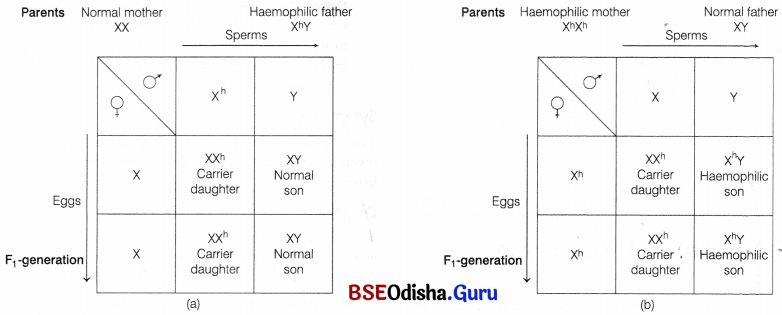
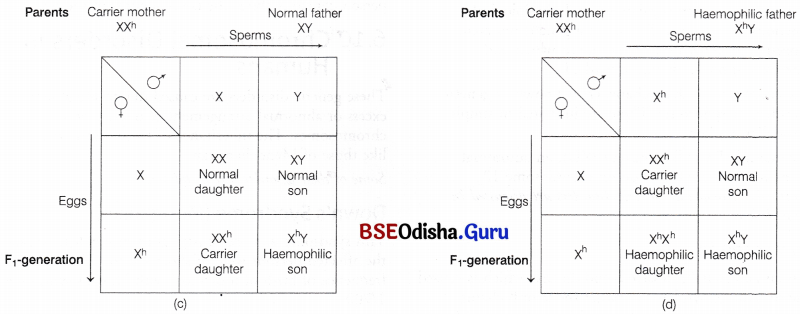
Four crosses explaining the inheritance of haemophilia allele in human, (a) Normal mother and haemophilic father, (b) Haemophilic mother and normal father, (c) Carrier mother and normal father and (d) Carrier mother and haemophilic father
Inheritance of Red-Green Colour Blindness:
It is a sex-linked recessive disorder, which results in defect in either red or green cone of eye. It does not mean the incapability to see any colour at all, infact it leads to the failure in discrimination between red and green colour. The gene for colour blindness is present on X-chromosome.
It is present mostly in males (XCY) because of the presence of only one X-chromosome as compared to two chromosomes in females. A heterozygous female has normal vision, but is a carrier and passes on the disorder to some of her sons. Its inheritance pattern is similar to that of haemophilia.
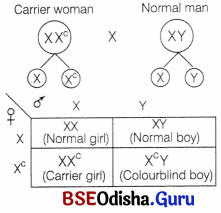
Question 4.
Give an account of sex linkage in Drosophila and man.
Ans.
Sex linkage is the phenotypic expression of an allele related to the allosome of the individual. In autosomal chromosomes both sexes have the same probability of existing but since humans have many more genes on the female X-chromosome than on the male Y-chromosome, these are much more common than Y-linked traits. Examples of sex-linked traits in humans are haemophilia and colour blindness (for detail refer to text on page no. 147-148).
Thomas Hunt Morgan discovered sex linkage in fruitfly. It supported the chromosomal theory of heredity.
Morgan proposed that the inheritance of eye colour is related to the sex of the offspring. He found that the gene for eye colour is located on X-chromosome. There is no corresponding allele for this trait on Y-chromosome.
Example During the cross between white-eyed male and red-eyed female, the F1-flies (both male and female) were all red-eyed indicating that white eye colour is recessive to the normal red eye colour.
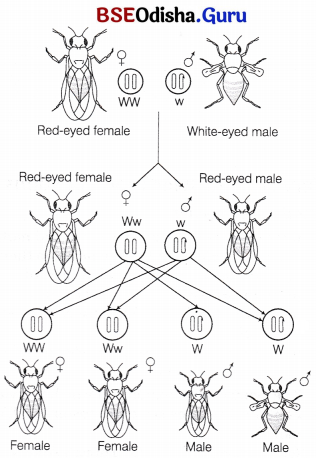
A cross between red-eyed female and white-eyed male showing sex-linked inheritance in Drosophila
